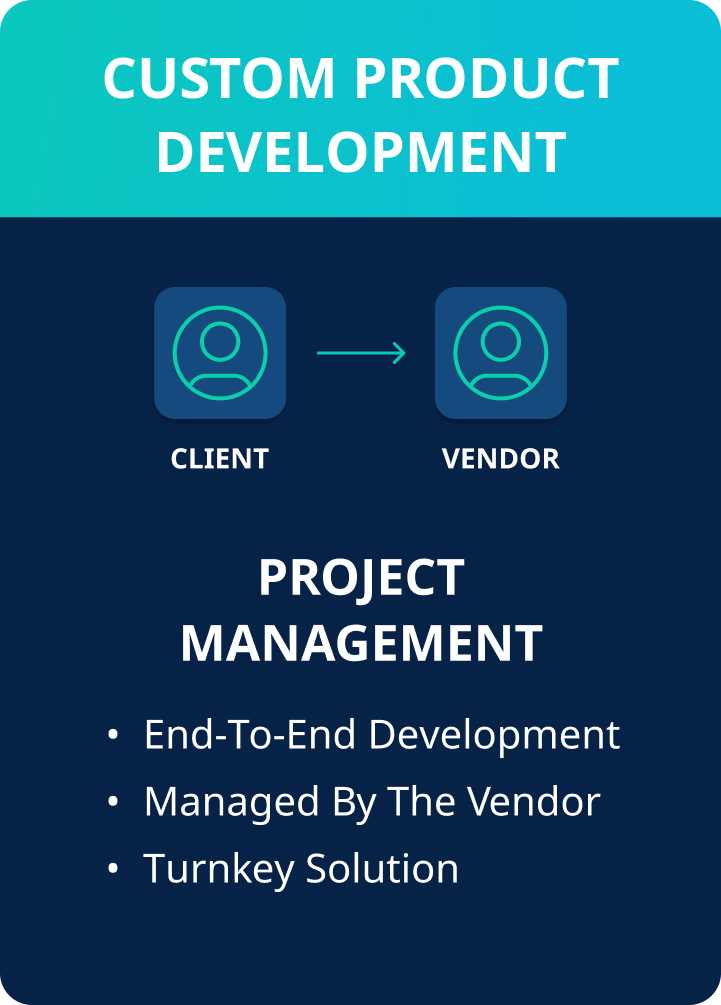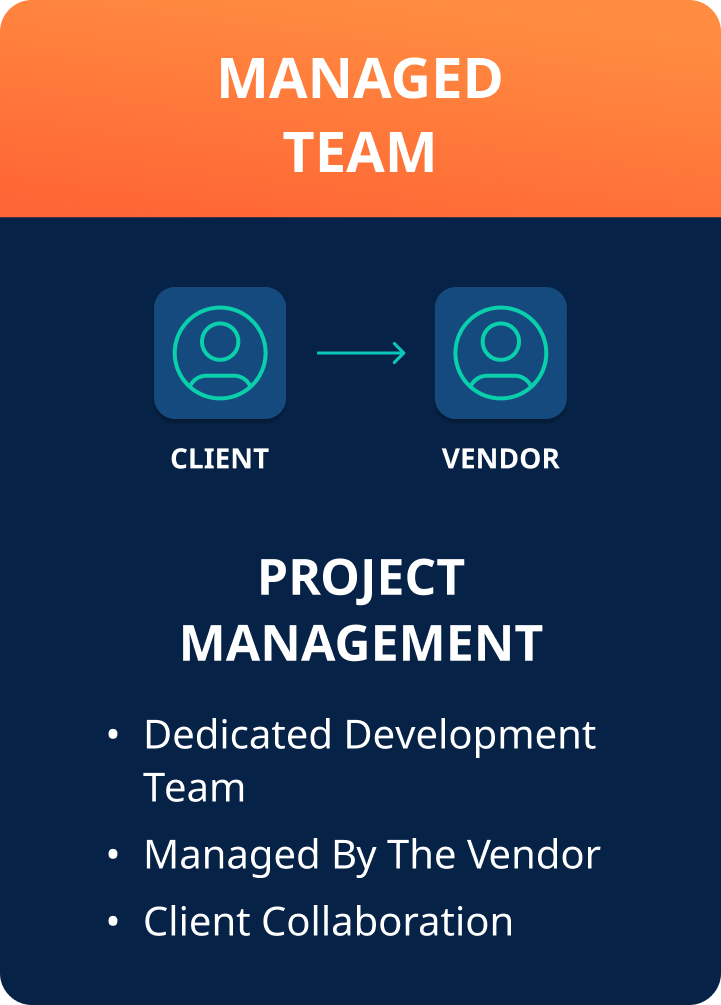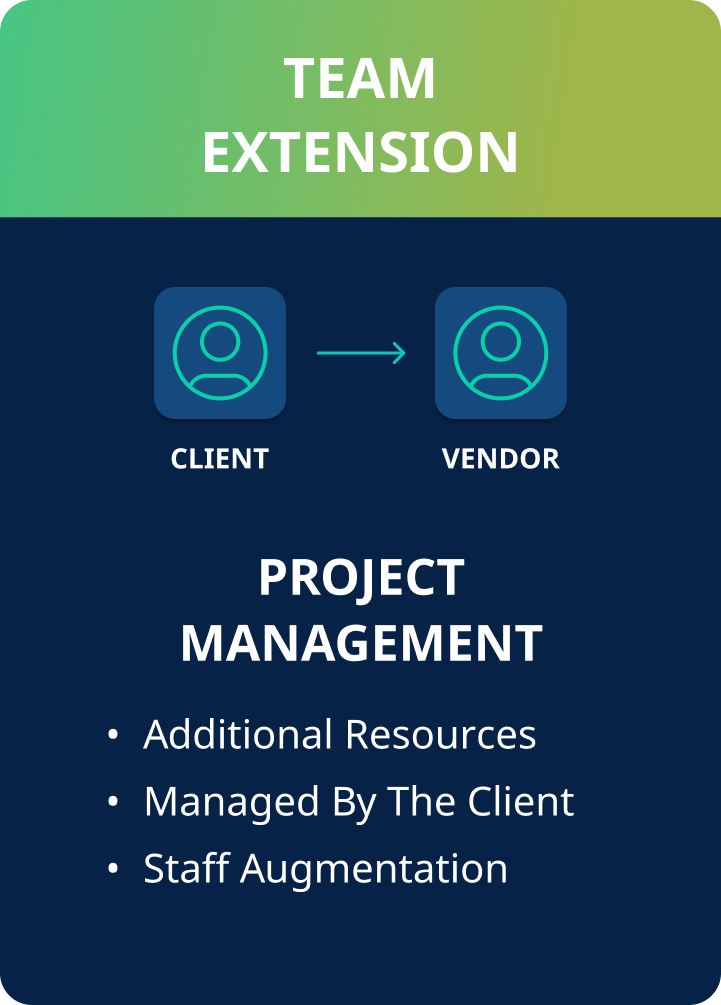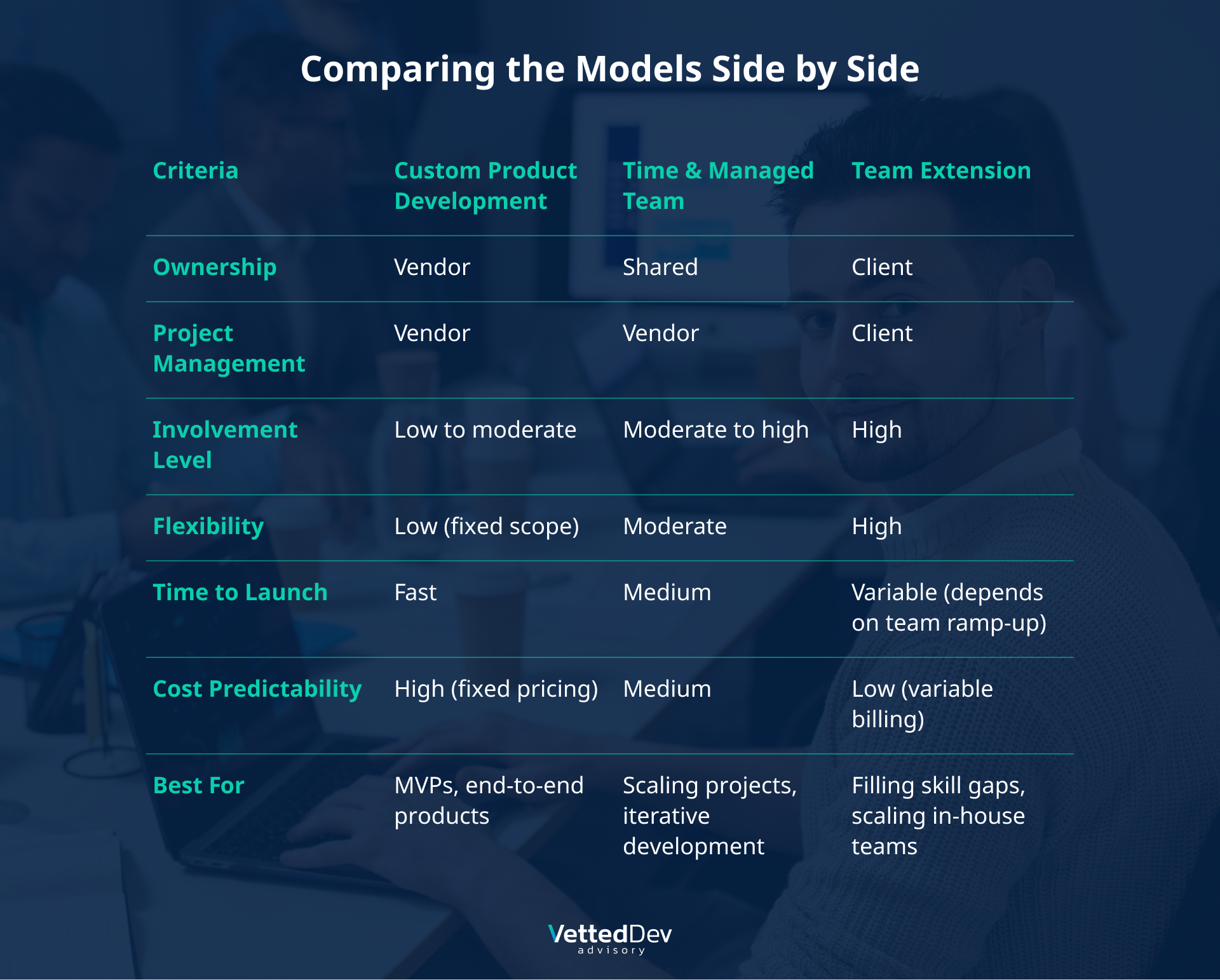Comparing the 3 Main Software Development Outsourcing Engagement Models:
Custom Product Development, Managed Team, and Team Extension
By VettedDev.net
Introduction
Outsourcing software development has become a core strategy for startups, scale-ups, and enterprises alike. It offers flexibility, scalability, and access to a global talent pool—all while optimizing operational costs. However, choosing the right engagement model can significantly impact project success. Each model comes with its own advantages, challenges, and ideal use cases.
In this comprehensive guide, we’ll break down and compare the three primary software development outsourcing models:
- Custom Product Development
- Managed Team
Team Extension We’ll explore their structure, ownership dynamics, pros and cons, and when each is the best fit.
1. Custom Product Development

Overview
Custom Product Development (also known as end-to-end development or full-cycle development) is a turnkey solution where the vendor takes full responsibility for delivering a working product. This includes:
- Requirements gathering
- UI/UX design
- Architecture and infrastructure planning
- Development
- Quality assurance and testing
- Deployment
- Post-launch maintenance
The vendor handles everything from A to Z. The client simply provides the product vision, business goals, and high-level requirements, and the vendor transforms it into a fully functioning product.
Key Characteristics
- Vendor accountability: The outsourcing partner is responsible for timelines, delivery, and quality.
- Minimal client involvement: Clients are involved in high-level decision-making, but day-to-day management lies with the vendor.
- Full project lifecycle ownership.
Pros
- One-stop-shop: Ideal for non-technical founders or companies without internal product teams.
- Faster time to market: Vendors bring reusable assets, frameworks, and domain expertise.
- Accountability: Responsibility for delivery and risk is on the vendor.
- Simplified communication: One point of contact (PM or product owner) simplifies updates and feedback.
Cons
- Less control: Clients may feel disconnected from the day-to-day operations.
- Rigid contracts: Changes after the scope is locked in may require additional negotiations.
- Risk of misalignment: If not properly scoped or communicated, expectations may diverge.
Best For
- Startups building an MVP from scratch
- Non-tech companies launching digital products
- Enterprises developing self-contained modules or standalone products
2. Managed Team

Overview
A Managed Team (also called a dedicated team or delivery team model) involves assembling a dedicated group of professionals—including developers, testers, and possibly project managers who work exclusively on the client’s project. However, unlike team extension, the vendor still retains responsibility for delivery, progress tracking, and quality assurance.
Clients retain high-level strategic oversight but rely on the vendor for day-to-day project management and team coordination.
Key Characteristics
- Dedicated team: The vendor builds a team tailored to the project’s needs.
- Shared responsibility: The client owns the product vision, while the vendor ensures execution.
- Ongoing collaboration: Communication between client and vendor is frequent and essential.
Pros
- Flexible scaling: Teams can be expanded or contracted as needed.
- Balanced ownership: Clients maintain influence without micromanagement.
- Domain expertise: Vendors bring their own frameworks, best practices, and toolsets.
- Continuity: Long-term engagements foster team familiarity with the product.
Cons
- Dependency on vendor’s management efficiency: A weak PM on the vendor side can derail progress.
- Knowledge transfer needed: Onboarding time is required for complex domains.
- Time zones and communication gaps: Still a factor depending on the vendor’s location.
Best For
- Companies with a product roadmap but limited engineering capacity
- Teams scaling beyond internal bandwidth
- Projects requiring ongoing development and iteration
3. Team Extension (Staff Augmentation)

Overview
Team Extension is the most flexible and granular engagement model. In this setup, clients “rent” developers or technical specialists from the vendor to augment their existing in-house team. These external team members report directly to the client, who handles all task assignments, project management, and quality control.
The vendor provides the talent, but the client provides the leadership.
Key Characteristics
- Client-driven: The client controls the workflow, task delegation, and overall project management.
- Time-and-material billing: Developers are typically billed by hour or month.
- High integration: Developers act as an extension of the internal team.
Pros
- Maximum control: Ideal for companies with strong internal leadership and well-defined processes.
- Cost-efficient: Pay only for what you use.
- Fast scaling: Quickly add new resources to fill skill gaps or ramp up development.
- Cultural alignment: Long-term staff become fully embedded in company culture and practices.
Cons
- More oversight needed: Requires strong internal project management.
- Onboarding and integration: New developers may take time to get up to speed.
- Risk of fragmentation: Without good documentation and practices, knowledge can become siloed.
Best For
- Tech-driven companies with established development workflows
- Startups with a CTO managing the team directly
- Enterprises supplementing internal teams for specific features or phases


Final Thoughts
Choosing the right engagement model is not just about budget or speed. It’s about aligning your internal capabilities with the right level of vendor support. Each of the three primary models – Custom Product Development, Managed Team, and Team Extension offers a unique value proposition depending on your product maturity, organizational structure, and internal bandwidth.
Custom Product Development is ideal when you need to offload everything and focus on go-to-market strategy.
Managed Team strikes a balance, giving you domain expertise and execution support while keeping strategic ownership.
Team Extension offers the most control and flexibility, ideal for scaling internal teams or fast-moving product companies.
Still unsure which path is right for you? At Vetted Dev, we help companies assess their goals and match them with the right engagement model and the right developers.
Whether you’re looking to build a product from scratch, scale your engineering team, or augment your in-house talent with world-class developers, we’ve got you covered.
For more insights on finding the right outsourcing partner? Visit VettedDev.net for guides, tips, and curated recommendations.
